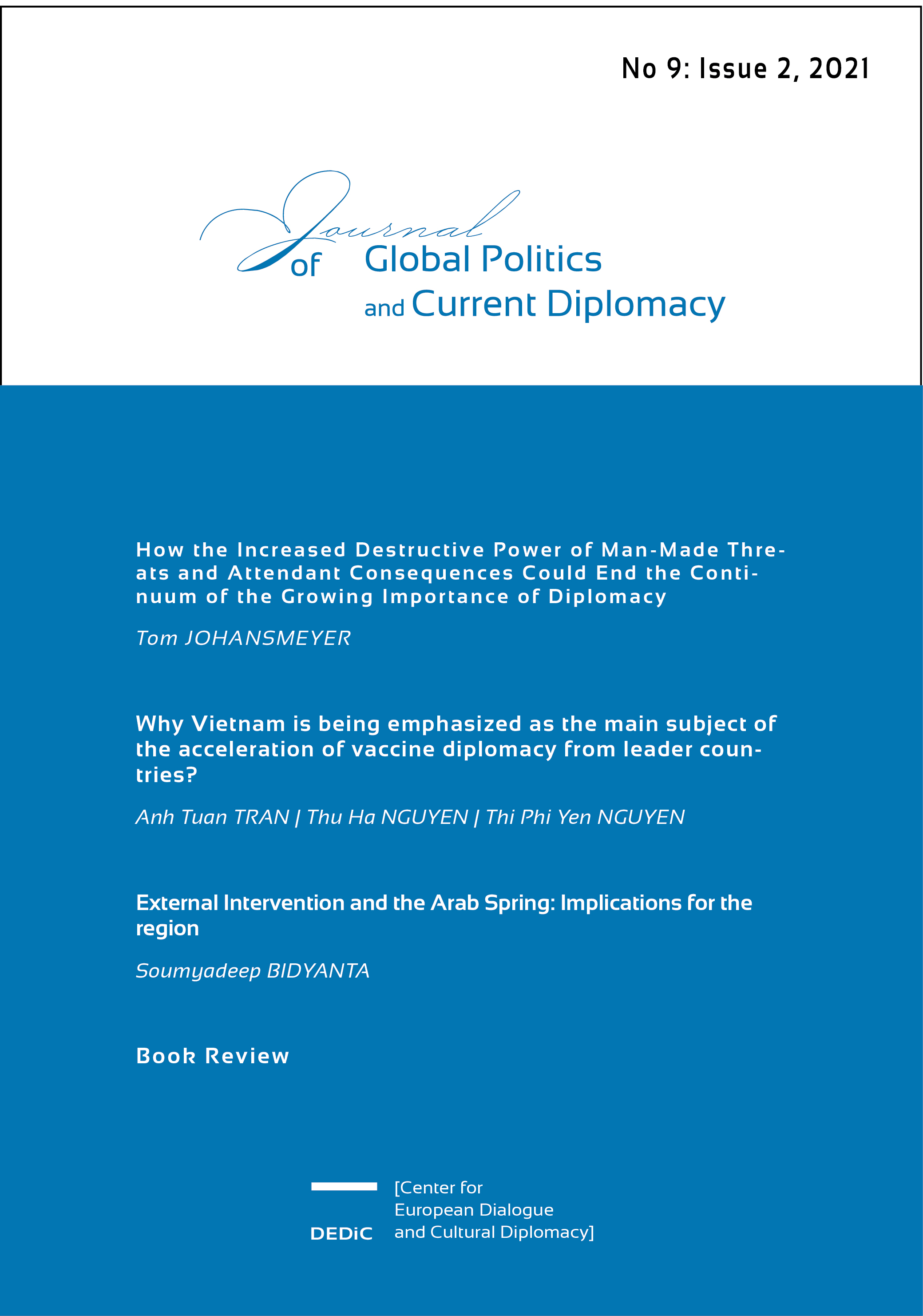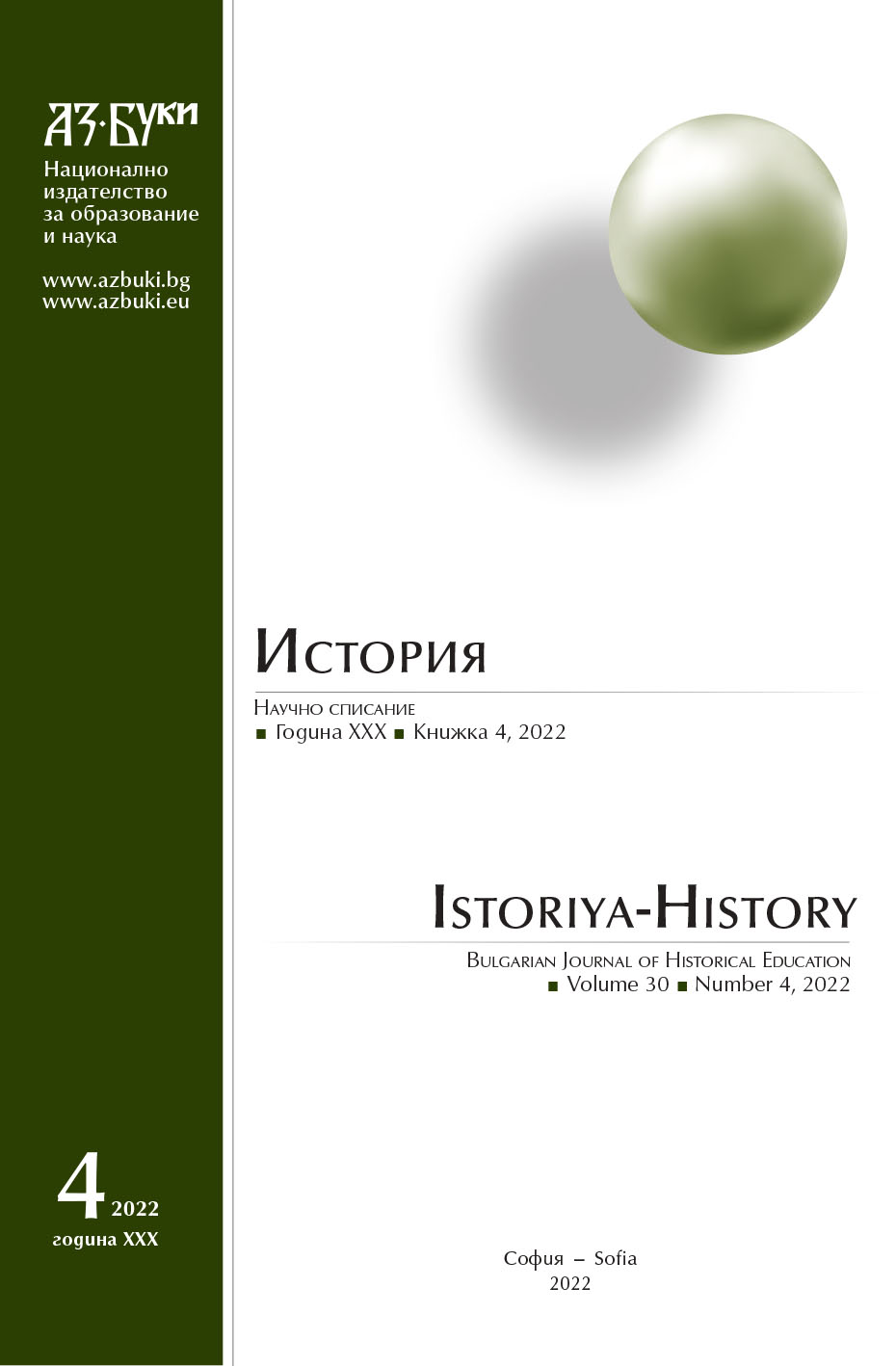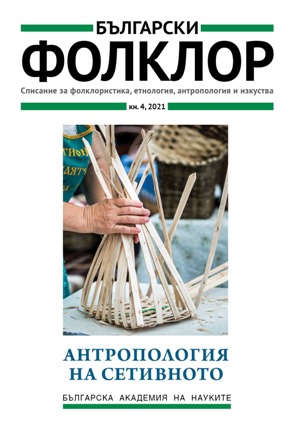
We kindly inform you that, as long as the subject affiliation of our 300.000+ articles is in progress, you might get unsufficient or no results on your third level or second level search. In this case, please broaden your search criteria.



Content of the main Bulgarian scientific journals for the current year in linguistics, literature, history, folklore, ethnography, archaeology, and art studies
More...
The article presents archival materials and other historical sources which keep primary information about the death and funeral of the famous Bulgarian rebel leader Hadzhi Dimitar Asenov (1840 – 1868) who originates from the town of Sliven. The widely accepted thesis that Hadzhi Dimitar was deadly shot during the Buzludzha battle (18th July 1868) and was buried at the place of the battle has been proven once again by bringing new motives and logical arguments. The funeral of the famous revolutionary on the Buzludzha peak (named in 1942 Hadzhi Dimitar peak) has been confirmed with memorial and archaeological pieces of evidence. Both re-burials of the fallen heroes (1898 and 1961) provide additional data in that direction. Despite scientific argumentation of the said thesis, the article also interprets some uncertain and contradictory evidence about the eventual death of Hadzhi Dimitar on the Kadrafil peak, located in the Sredna gora mountain – 50 km away from Bualudzha peak in the Stara planina mountain. Neither factual nor logical arguments of this legend withstand scientific criticism. Nevertheless, they are persistently popularized by local patriots, originating mainly from the village Svezhen (formerly called Ajar – until 1934). Furthermore, supporters of the so called Adjar's legend are trying to give national status of their unscientific claims about the death and burial of the famous revolutionary leader Hadzhi Dimitar Asenov. Their unjustified actions are conceptualized in the scientific context of the cultural memory theory. The dispute between the scientific version and the Adjar's legend is explained by the different approaches of historical science and cultural memory toward a single fact from the past – the last moments of a national hero's life. The professional historiography works with objective facts, scientific methods and logical arguments. Cultural memory attracts convenient hypotheses, mythological plots and unprovable local memories.
More...
The article presents unknown documentary evidence from the archival heritage of Acad. Ivan Simeonov Duichev (1907 – 1986), stored in the Center for Slavic-Byzantine Studies “Prof. Ivan Duychev” (CSVP). In terms of content, they represent a valuable historical source, containing information about his research activities and interests in archival science in the 50s of the twentieth century. The sources and archeographic aspects of the newly discovered document are considered. The contributions of Acad. Duychev in the field of theoretical archival science after the publication of his “Lectures on archival science” in 1950are presented.
More...
The goal of this paper is to investigate the memory of the Holocaust, i.e. the reception and representation of the suffering of the Jewish population during the rule of the Third Reich (under Nazi rule and occupation) in the capitals of the states constituted after the Second World War - in East Berlin, GDR, and Belgrade, SFRY, during the period from 1945 to 1989/1991. Relying on the achievements of memory studies and analyzing the political moods of that time and the ways of constructing official narratives about Jewish suffering in selected post-war Communist countries, the similarities and differences in the policy of representing Jewish suffering in these two countries and the memory of Jewish victims in places of remembrance and in the practices of remembrance in their capitals will be pointed out.
More...
This paper aims to reconstruct the way in which the Romanian written culture from the second half of the eighteenth century and the beginning of the nineteenth gradually built the image of the Russian Enlightened monarchy with three of its most famous representatives: Peter II, Catherine II and Alexander I. By means of translating from Italian and German historiography, these texts served a double goal: on the one hand they satisfied the reader’s need for knowledge and understanding of the contemporary events, and on the other they contributed to a political discourse that viewed Russia and the Russian Orthodox monarchy as potential saviours of the Romanian principalities from the oppression of the Muslim Ottoman Empire. By means of translation analysis, we have attempted to illustrate how the Western image of an Eastern monarch, guided by a blend of Western philosophy and Eastern Orthodox tradition, was transferred in the Romanian culture as a scientific base for political and cultural decisions.
More...

Our study demonstrates that the analysis of culture should be embedded into the history of capitalism. Through this understanding of culture's materiality, we highlight that culture is not only a spiritual but also a materially embedded phenomenon. We argue that this analysis is also essential to outline culture's role in a post-capitalist world.Our study offers four perspectives to analyze the diverse, often indirect, relationship between culture and capitalism. We show how the diversity of culture is more than heterogeneity but rather part of class conflicts and struggles. By examining the cultural institutions, our paper points out that they play a crucial role in the reproduction of the laborforce. It also points out that global and nation-state-led cultural production are not contradictory but entangled phenomena. Finally, our paper emphasizes that the relationship between culture and capitalism cannot be understood as abstract laws but must also always consider the social trajectories of professional cultural producers, who are a central but often invisible dark matter.
More...
The text reviews the scientific monograph of Nurie Muratova ‚Women beyond the Archive. Invisible Histories of Women in Bulgaria‘, published by University Press ‚Neofit Rilsky‘ in Blagoevgrad. The book explores the place in the Bulgarian and world archives of two marginalized social groups – women and women with minority status. It is established that their visibility and invisibility, accessibility and secrecy, significance and underestimation depend on certain archival policies, social conditions, social stereotypes and prejudices.
More...
This article highlights the politics of the early Turkish governments towards various ethnic, linguistic and religious minorities living on the territory of the Republic of Turkey in the light of the principle of nationalism, which became one of the fundamental principles of the new Turkish state. Based on the achievements of modern historiography and the archive documents in the records of the Ministry of Foreign Affairs and Religions kept at the Central State Archives –Sofia, it makes a review of the typical practices aimed at assimilation of the Muslim linguistic, ethnic and denominational minorities, on one hand, and, on the other hand, at the exclusion of non-Muslims from the concept of the “Turkish nation” and the adoption of discriminatory, and even repressive practices, encouraging their emigration from the Republic of Turkey.
More...
The article examines one of the little-known and unexplored episodes of Soviet government campaigns for the re-emigration of Bulgarian citizens of Russian descent, who were deported to the Soviet Union in the autumn and winter of 1946 – 1947 and settled in the southern, south-eastern and western regions of Ukraine. The demographic statistics of the contingent of migrants, the circumstances of the transportation of ‘re-emigrants’ to Ukrainian ports, their distribution in the regions of the Ukrainian SSR, resettlement, housing and employment locally have been analyzed. The main sources of the study are the documents of the Department for Repatriation of the Council of Ministers of the Ukrainian SSR, which are stored in the funds of the Central State Archive of Supreme Bodies of Power and Government of Ukraine in Kyiv. They include records, directives, instructions, resolutions, reports, information, notices, letters and telegrams of the authorities of the USS Rand the Ukrainian SSR at various levels. These documents reveal the details of the preparation and implementation of the resettlement of hundreds of Bulgarian citizens of Russian descent to Ukraine in the autumn and winter of 1946 – 1947by the Stalinist authorities and provide statistics on the number, gender, age and occupation of ‘re-emigrants’, information on their transportation to Ukrainian ports, reception and accommodation of people in their new places of residence, the reaction of migrants to the actual living and working conditions in their new homeland. The vast majority of immigrants were associated with the Soviet Union only by the Russian descent of their ancestors, so one cannot call these people “repatriates”, as the Stalinist government did. Given the nature and consequences of this action of the Soviet totalitarian regime, we can rather talk about forced displacement on ethnic grounds.
More...
The article discusses notions referring to the ruler and his body according to the pagan views of the Bulgarians in the epoch before Christianity was adopted in the Bulgarian lands. Drawing on written sources and material evidence, an attempt is made to interpret ideas, signs and objects which form the system of the ruler’s ideology. Typological similarities are pointed out between the ruler’s ideology of the Bulgarians and that of the peoples of the Eurasian Steppes, Central Asia, and with other peoples from the Migration period.
More...
We publish a conversation of the journalist Irina Nedeva with Roumen Avramov, economist and historian, on the occasion of the Bulgarian translation of Nadège Ragaru’s book ‘Et les Juifs bulgares furent sauvés…’. Une histoire des savoirs sur la Shoah en Bulgarie’, Sciences Po. Les Presses, 2020) (“And the Bulgarian Jews were saved...” History of knowledge about the Holocaust in Bulgaria”). The conversation was broadcast on November 8, 2022 in the “Horizont do obed” ("Horizon by noon") program of the Bulgarian National Radio; the text published here is a transcription of it. The questions have been preserved, and in the answers Rumen Avramov has made some stylistic edits, as well as brief substantive additions and clarifications
More...
Review of: Faces, icons and books for the soul: Moldavians in Ukraine, Ukrainians in Moldavia. Testimonies of sacred art; 16th-19th centuries, exhibition organized by the Metropolitan Museum of Iași between April 14 and August 14, 2022, to support Ukrainian refugees. Vladimir Ivanovici and Alice Isabella Sullivan (eds), Natural Light in Medieval Churches, Series: East Central and Eastern Europe in the Middle Ages, 450-1450, Volume 88 Leiden and Boston, Brill, 2023 Daniela Marcu Istrate, Church Archaeology in Transylvania. (ca. 950 to ca. 1450), Leiden and Boston, Brill, 2022, 522 p. Daniela Marcu Istrate, Dan Ioan Mureșan and Gabriel Tiberiu Rustoiu (eds), Christianization in Early Medieval Transylvania. The Oldest Church in Transylvania and Its Interpretation, Leiden and Boston, Brill, 2022, 499 p. Mihail K. Qaramah, O istorie a Molitfelnicului Românesc. Evoluția formularelor Sfintelor Taine (sec. xvi-xvii) [A History of the Romanian Euchologion: The Evolution of the formularies of the Sacraments (16th -17th c.)], Alba Iulia, Editura Reîntregirea, 2022, 310 p.
More...
Dacia was, between 106 and 275 AD a Roman province , known under the surname of Dacia Felix. Our contribution takes advantage on a circumstance, at least as happy as the province was considered to be: the existence of the wax tablets of Alburnus Maior (nowadays Roșia Montană, in Alba County, Romania . Also known as Triptychs, some are valuable sources of historical and legal informations, while others simply record scenes of social life. Uncovered between 1786 and 1855 out of the former provincial golden mines, they are a priceless account of the way locals transplanted the Roman Classical Law. In fact, this very direct application of Roman Law in the Dacia province was, among other Transylvanian epigraphic testimonies , also demonstrated by these waxed tablets (tabulae ceratae Alburnense ). Those juridically relevant were studied by Romanian legal historians such as Ion Peretz, Ion Baltariu , Vladimir Hanga . Our purpose here is to give a brief account on how the vulgarisation of Roman Classical Law took place in this part of the Empire.
More...
At the time of the conquest of Dacia, Rome was in terms of the form of government, in the phase of the Principate, the era inaugurated by Octavian Augustus. In terms of territory, Rome ruled a vast territory stretching from England to the Middle East and from Gaul to Egypt. Immediately after the conquest, Dacia entered the process of administrative, economic and military integration, as provided by the rules of Roman public law. According to these rules, it was organized as a separate province, with its own administrative, military and fiscal authority.
More...
Ancient Niš, better known as Naisus, was a developed settlement with a certain population that tended to grow over time. Historical sources say that the city had the status of a Roman municipality, which means that it had a very organized system of life. The size of ancient Naisus has not yet been fully determined, but considering the existence of the suburban part of Mediana, as well as the widespread villas around Mediana, it can be said that it occupied a good part of the Niš basin, crossed by the river Nišava as the main and largest watercourse in that region and that as an impregnable military stronghold, it was an important economic and cultural center of the Roman Empire. Naisus occupied a central position in the Roman province of Upper Moesia, which spread over the territory of today's Serbia. The original military fortification was created in the last decades of the 1st century BC on the right bank of Nišava and was the center of the various tribes: Dardanians, the Thracians and, briefly, on two occasions, the Celts, whose homeland is distant Gaul. A new period in the history and life of Naisus began at the beginning of the 4th century AD with the arrival of Constantine on the throne of the Roman Empire, the Roman emperor, one of the historical rulers who completely redirected the future of not only Christian Europe, but also the civilization known to us today.
More...
The geographical space of the development of the Serbian medieval state was part of the origin and development of Roman law. The Serbian medieval state and its law would inevitably be created on the basis of the Byzantine tradition. The Byzantine Empire itself was the Eastern Roman Empire both by tradition and by all the features of society, state, law, and even by name. Its law and state organization, adapted to the new social relations and feudal order, were not negations, but a continuation of the Russian state-legal tradition. In such an environment, the Serbian medieval society and the Serbian state developed on the foundations of this tradition, incorporating their customary law into it. Serbian medieval legislation, rounded off by Dušan's Code, is a material witness to the aforementioned postulates.
More...
Data about scientific events in the field of the humanities in Bulgaria in the second half of 2022
More...